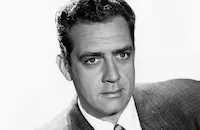The films of the dauntingly prolific B-movie filmmaker Edgar G. Ulmer run the gamut from low-grade schlock to high cinematic artistry, the two modes often twisted together within the same movie. After being exiled from the major studios in the mid-30s, Ulmer transferred his dark, pictorial style to Poverty Row, where he made low-budget movies for years, some of them undistinguished, others magnificent (like the improbably canonized Detour, 1945), but every one of them a highlight in B-movie history.
However, Ruthless, from 1948, can scarcely be called a B-picture, boasting reasonably big-name stars and a budget that consistently makes itself felt – the film’s opening minutes alone pack enough opulence for a dozen earlier Ulmer productions. Adapted from a Dayton Stoddart novel called “Prelude to Night,” this story of a vicious finance mogul with a rags-to-riches background opens with striking grandiosity at the character’s stately mansion, as chandelier-anchored compositions survey the colossal ballroom where Horace Vendig (played superbly by Warners regular Zachary Scott) announces a new philanthropic venture. In attendance is an old friend (Louis Hayward) with a beautiful and hauntingly familiar companion (Diana Lynn), who together give the lie to Vendig’s beneficent public image. Old wounds soon reopen, and a rather elaborate flashback structure relays the story of Vendig’s rapid ascent up the economic ladder – from poverty to Harvard, from Harvard to the upper echelons of Wall Street.
The plot takes a number of intriguing detours. Lynn performs double duty as Vendig’s first flame, and the second half of the film is given almost entirely to Vendig’s battle with a utility baron played by Sydney Greenstreet, whose discontented wife (Lucille Bremer in what would prove to be her penultimate screen performance) plays a pivotal role in Vendig’s moral decline. It is not always the most airtight story, and the ins and outs of Vendig’s business dealings at times lack for dramatic interest, but the visual atmosphere is never less than captivating. Ulmer and cinematographer Bert Glennon (Stagecoach, 1939; They Died with Their Boots On, 1941) constantly find occasion for slightly skewed camera angles and sinuous tracking shots, creating a noir-ish universe in which everything from a front stoop to a billiards table gives off expressionistic menace.
When Ruthless was released, Variety had nothing but harsh words – “cliched and outmoded direction,” “confusing,” “performances…handicapped,” “weary dialog,” and so on. Buried in this string of pejoratives is the perceptive recognition of the movie’s similarity to Budd Schulberg’s great and prescient novel “What Makes Sammy Run?,” whose eponymous hero – very much like Vendig – chases upward mobility with a crazed, amoral intensity that leaves friends, benefactors and lovers in his wake.
Ruthless may not exactly be a lavish production by Hollywood’s usual standards, but for the so-called ‘King of the Bs,’ it’s more than enough. Reconsideration of the film over the years has brought it critical acclaim. It has been compared to Citizen Kane (1941) for the Xanadu overtones of Vendig’s manor, for its complicated flashback structure and for its portrayal of the spiritual dead-end of exponentially outsized ambition. Scott’s performance is more than equal to the thematic richness of the material; it’s as if he had been given the opportunity to fully probe the backstory of one of the villains that were his stock in trade at Warner Brothers. The success of Ruthless is just as much his as it is Ulmer’s.
Ruthless was produced as a one-off venture by a theatrical agent named Arthur S. Lyons for reasons which are not entirely clear. But whatever motivated Lyons’ decision, we have him to thank for Ulmer’s renewed access to studio resources that had been denied to him for years.

























